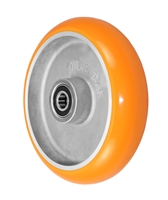Need Bulk Deals or Expert Advice? | Contact us for Exclusive Discounts!
Hours: Mon-Fri: 8AM-5PM CST | 844.439.4335
Need Bulk Deals or Expert Advice? | Contact us for Exclusive Discounts!
Hours: Mon-Fri: 8AM-5PM CST | 844.439.4335

Ergonomic Casters have been around for many years. Still, not many people know what characteristics ergonomic casters include and how ergonomic casters can benefit anyone operating these types of casters. To begin, a Caster is a complete apparatus that consists of the swivel or rigid yoke/frame and the wheel. Once you assemble all of the components, it makes a complete caster. The Swivel Yoke (Caster Frame that holds the wheel) is just as important as the ergonomic wheel used in any application to make a complete ergonomic caster. When you hear the word caster or caster wheel, it doesn't necessarily pique most people's interest.
For those looking to reduce push/pull force, increase safety and performance, reduce downtime, and prevent workers comp claims, this may pique your interest as it directly affects your job. Workplace safety and ergonomics are essential in many industrial manufacturing plants, warehouses, and factory floors where operators manually push carts daily. Any business where a human or a power tugger operates platform trucks, carts, dollies, or equipment will significantly benefit from using an ergonomic caster. Below you will find the top characteristics and benefits of using an ergonomic caster.
The wheel material is the most crucial factor when choosing an ergonomic caster. In the caster industry, there are over 12 Wheel Types, and within those there are more than 21+ different types of material wheel combinations. An ergonomic wheel is typically going to have a special kind of polyurethane wheel material. Still, it is manufactured in a specific way that has been tried and tested by engineers, ergonomists, universities, and industrial laboratories to outperform all of the standard wheels on the market to incorporate seven exceptional characteristics that are not found in a standard caster wheel.
Durometer & Thickness of Polyurethane
The shape of the Wheel
Diameter of Wheel
Ergonomic Casters Wheels are made of a special proprietary blend of a Polyurethane Tread that does not compare to any other polyurethane wheel on the market.
To increase ergonomics, we have to provide a wheel with a tread hard enough to roll with ease but soft enough to roll over debris, grip the floor, and reduce the sound/decibels to make it as silent as possible, all at the same time. The Durometer is between (85-87 Shore A), which is softer than a standard polyurethane wheel, the standard allows the wheel to have much more resilience and a rebound effect not found in a normal polyurethane wheel.
Recently, we performed our own in-house and 3rd party tests, and we saw a reduction in push/pull by over 53%.
Another benefit of our ergonomic casters is the wheel shape. It is made specifically to reduce rolling resistance, also known as Hysteresis. The less contact the tread has to the ground, the less rolling resistance one will experience. Other factors that increase ergonomics include the thickness of the tread, durometer of the tread, rebound/resistance, shape, and even bearings used to improve the initiation and rollability of the wheel itself.
The Caster Frame/Rig/Yoke all go by many names, but this is the apparatus that holds the wheel. The swivel housing, known as the swivel raceway, is what contains the ball bearings to allow the swivel caster to rotate in a 360-degree motion. The Yoke of the caster is also a very crucial piece when achieving a genuine ergonomic caster.
An ergonomic swivel caster combines Thrust Ball Bearings and Taper Roller Bearings for maximum performance. Our Ergonomic casters consist of Taper Roller Bearings in the upper raceway to handle axial loads while operating at high walking speeds. Ball Thrust Bearings are used in the lower raceway to handle combined heavy radial and thrust loads.
Another critical factor in the swivel yoke would be an extended swivel radius which reduces the force to start and swivel by 50% on average. This type of caster can be found in a yellow zinc chromate finish which is resistant to rust and corrosion for many harsh applications, protecting your investment and increasing the life of the overall caster. Another secret that is now public information is we use hardened chrome steel ball bearings along with a hardened chrome steel inner raceway that holds the ball bearings. Having the same materials reduces friction to almost zero and allows a smooth and easy swiveling raceway, reducing push/pull force and increasing ergonomics and safety.



